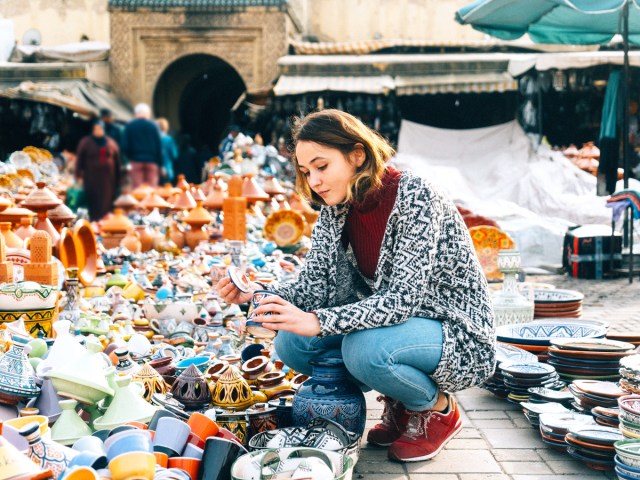Who doesn’t love a travel souvenir? A 2018 YouGov survey found that 65% of Americans like to bring back souvenirs from vacation. From collectibles to clothes, we all have our favorite items to bring back from a trip. But that doesn’t mean anything goes when it comes to souvenirs, especially when traveling to another country. Whether they are protected or restricted items, or simply impractical, here’s what to avoid when you’re in the mood to splash some cash on a vacation abroad.
Fruit, Vegetables, and Other Natural Products

Many countries — including the U.S. — pay particular attention to the import of food products such as fruit and vegetables. Protecting the agricultural industry and the livelihoods of those employed is crucial, so every step must be taken to ensure diseases and pests aren’t introduced accidentally. According to the U.S. Customs and Border Protection website, a Mediterranean fruit fly outbreak that began after a traveler brought back a single piece of fruit in 1980 cost approximately $100 million to rectify. It’s not just food, either. The CBP warns against importing certain animal hide drums for an even more concerning reason — they may pose a low risk for cutaneous anthrax transmission.
Electronics

In some parts of the world, electronics retail for far less than they do in the U.S., but that doesn’t necessarily make purchasing them abroad a good idea. There are several reasons why that cheap deal may not be so cheap after all — not least the chance that you’d have to pay customs duties. Smaller details may become an obstacle, too. For example, laptop keyboards can differ from country to country, and user instructions might not be translated into English. Faulty goods will be almost impossible to return, and warranties may not be valid in your country of residence. Plus, electrical standards, voltage, frequency, and plug type vary considerably around the world, so what you buy may not be compatible when you arrive home.
Restricted Antiques and Cultural Artifacts

A country’s art, antiquities, archaeological finds, and ethnological treasures form part of its cultural makeup, and visitors have a responsibility to ensure they don’t remove them and take them overseas, even unwittingly. Such items governed by strict import regulations include Indigenous artifacts from Canada and pre-Columbian archaeological objects from Guatemala, El Salvador, and Peru. When in doubt, we should leave them where they belong. An illustrated coffee table book or modern-day replica from a museum’s gift store would make a much more acceptable alternative.
Pirated Music and Movies

Knock-off CDs, DVDs, and Blu-rays are a common sight in markets in some parts of the world. It’s not difficult to spot a fake — these items are typically low-quality in comparison to official merchandise — but it’s not just about the viewing experience. Piracy is theft, and counterfeiting isn’t a victimless crime. Artists and creators have a right to be paid for their work, so resist the temptation to buy bootleg souvenirs and opt for legal downloads or streaming services instead.
Expensive Jewelry

If you’ve booked a trip overseas to celebrate a milestone birthday or important anniversary, you might be considering buying an expensive piece of jewelry to mark the occasion. When that’s the case, be sure that your research is thorough — reports suggest that these items could be significantly overpriced in some countries. Some establishments might sell gems at inflated prices to unsuspecting customers without mentioning that they have been fracture-filled (a practice of disguising flaws that must be disclosed), or some might sell items with fake certificates. Long story short: If you can’t be absolutely certain of a gem’s provenance, then take your money elsewhere.
Mass-Produced Items

At the opposite end of the spectrum are the items that somehow make their way into tourist shops all over the world. You know the stuff: T-shirts emblazoned with corny slogans, branded shot glasses and mugs in gaudy colors, or perhaps a poorly embroidered bag proudly displaying the name of your destination. The unfortunate reality is that most of these souvenirs start life far away from the places they promote and are typically mass-produced in factories. Instead, seek out quirky one-of-a-kind items or authentic artisan handicrafts to bring back something you’ll actually be proud to display.
Oversized or Breakable Souvenirs

Sometimes, we forget to consider the bulk or fragility of a souvenir purchase. The fun you had haggling over that rug or ceramic pot quickly evaporates as you try to figure out how you’re going to transport it back to the U.S. Shipping an item might be a solution, though there’s no guarantee it will arrive in one piece — even if it’s enveloped in industrial quantities of bubble wrap. Or, if it’s too heavy, you may be faced with excess baggage fees. Moral of the story: You’ll probably want to think twice about purchasing anything that might cause a headache transporting it home.
More from our network
Daily Passport is part of Optimism, which publishes content that uplifts, informs, and inspires.























